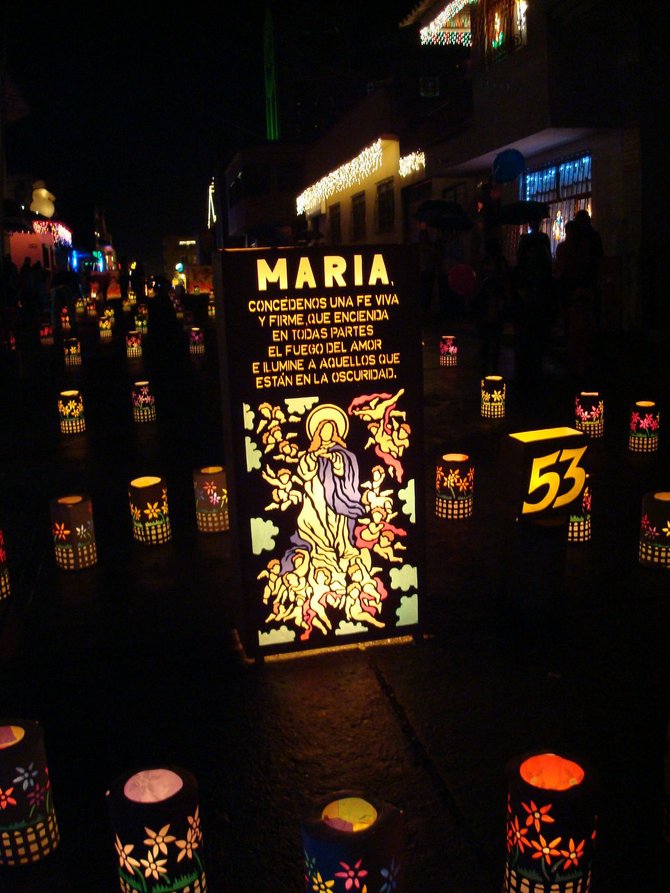 Facebook
Facebook
 X
X
 Instagram
Instagram
 TikTok
TikTok
 Youtube
Youtube

On December 8, 1854, Papa Pío IX established the dogma of the immaculate conception of Mary. Granted, the publication of a dogma is not very sexy, but for Colombians, the doctrine represents the kindling of a great light. It is celebrated with passion, fire and the most beautiful luminarias in the Western world.
December 7 is the Día de las Velitas, or the Alumbrado. In Quimbaya, a city in the high-green coffee zone of Colombia, Alumbrado takes on a singularly beautiful glow. The roads are closed down; the city nearly sleeps commercially. On the empty streets are paper lanterns with intricate colored-plastic windows.
Candles lit within pour soft light through the colored windows depicting Mary, the Christ child, local livestock or Colombian flowers — anything, really, that carries something of the local and eternal divinity as experienced by the rural Colombians. Some are 2 meters tall, with all the intricacy of a stained-glass window; other smaller lanterns are lined up on empty streets like toy soldiers, casting a prismic glow into the misty north Andean air.
Unfortunately, Colombia is a country where the people’s divine fire is often rained on — as we’ve just seen in the violence following Santos’s election. After lighting candles in thousands of bright boxes, the candle-lighters and illuminated tourists (us) had to take shelter as the boxes were snuffed by rain.
In the meantime, we cloistered ourselves in local taverns to eat empanadas and drink Coca-Colas — the Colombians’ answer to Dickens, hot cocoa and slippers. This is not the coastal Christmas I know. For many, Christmas is a season of light; during my time in Quimbaya I’ve found the kaleidoscopic expressions of this light are infinite.
Last Christmas the rain came, it stopped, the lanterns were relit, and kindled with a fervent glow until the first light of dawn.


On December 8, 1854, Papa Pío IX established the dogma of the immaculate conception of Mary. Granted, the publication of a dogma is not very sexy, but for Colombians, the doctrine represents the kindling of a great light. It is celebrated with passion, fire and the most beautiful luminarias in the Western world.
December 7 is the Día de las Velitas, or the Alumbrado. In Quimbaya, a city in the high-green coffee zone of Colombia, Alumbrado takes on a singularly beautiful glow. The roads are closed down; the city nearly sleeps commercially. On the empty streets are paper lanterns with intricate colored-plastic windows.
Candles lit within pour soft light through the colored windows depicting Mary, the Christ child, local livestock or Colombian flowers — anything, really, that carries something of the local and eternal divinity as experienced by the rural Colombians. Some are 2 meters tall, with all the intricacy of a stained-glass window; other smaller lanterns are lined up on empty streets like toy soldiers, casting a prismic glow into the misty north Andean air.
Unfortunately, Colombia is a country where the people’s divine fire is often rained on — as we’ve just seen in the violence following Santos’s election. After lighting candles in thousands of bright boxes, the candle-lighters and illuminated tourists (us) had to take shelter as the boxes were snuffed by rain.
In the meantime, we cloistered ourselves in local taverns to eat empanadas and drink Coca-Colas — the Colombians’ answer to Dickens, hot cocoa and slippers. This is not the coastal Christmas I know. For many, Christmas is a season of light; during my time in Quimbaya I’ve found the kaleidoscopic expressions of this light are infinite.
Last Christmas the rain came, it stopped, the lanterns were relit, and kindled with a fervent glow until the first light of dawn.
Comments